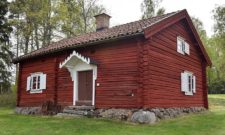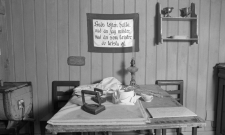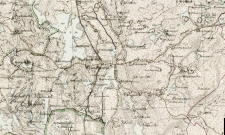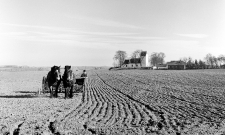Shop our historical maps

May
This opinion piece was published in Sydsvenska Dagladet on 14 September 1987. The newspaper commented: "Genealogist Carl Liljenberg illustrates, from the perspective of the emergence of state nationalism, how the Skåne nation was gradually incorporated into the Swedish state".
The relationship between the state and its regions was, before the age of state nationalism, a real problem only here and there in Europe. State nationalism can be dated to 1514, and its first victim was the Euskadi people of north-eastern Spain, who were crushed by the Spanish state. The Spaniards contemptuously called the Euskadi "vascos", from which European "Basques" emerged. In the same way, oppressed peoples have always had to put up with being given a bad name by the master race to designate their minority. For example, the Japanese used the term dog "ainu" to refer to Japan's indigenous white population.
The rise of state nationalism is linked to the medieval confrontation between church and state. Alongside the religious confession, which was the soul of the Church and which was without borders, a state-national confession was created, as a secular counterpart. But now the borders between different states came in as important elements. Colonialism and the Crusades also contributed to the formation of state nationalism with its concept of master peoples and colonial peoples.
State nationalism, in short, meant that the population of the capital came to be regarded as the only real national substance. The language of the capital would be the idiom of state power. What stood outside was either insignificant or directly hostile to the state. Thus began in earnest, among other things, the suffering path of Euskadi up to the present day. Many others have followed in the same footsteps.
European state nationalism spread rapidly across the continent, victoriously aided by European colonialism. It took on a particularly relentless character in Tsarist Russia and reached the Swedish Empire around 1675, i.e. in the time of Charles XI.
For the great Swedish power, state nationalism was still reasonably insignificant in 1658. Many different peoples and nationalities were gathered in the Swedish Empire and many of these peoples had a much higher culture than the primitive Swedes. Neither in quantity nor in quality could any Swedish master race be claimed.
By the peace of Roskilde 1658, the fateful 26 February for Skåne, it was established in §5 that Skåne, Halland, Blekinge and Bornholm were transferred to the Swedish kingdom. This was done against the will of the people of Skåne.
However, the peace did not at all mean that the population of Östansund would become Swedish. In §9 it is stated, among other things, that the new subjects of the Swedish crown would "remain at their usual right, law and old privileges" etc. This also included the full legal competence of the Skåne Law, the Skåne Church Court and the City Court.
Stockholm also recognised the "Skåne nation", i.e. the Skåne nationality and, through the constitution of the general government, the indivisible unity of Skåne as a whole or, as the official Swedish expression went, "the Skåne state", which was thus separate from the Swedish state. Skåne's new status included the institution of the Diet as the forum of the Estates. The General Governorate of Skåne existed from 1658 to 1693, and the Governorate of Skåne from 1693 to 1719.
Step by step, the independent status that was intended and agreed for Skåne was broken down. Skåne city law was abolished in 1682, church law in 1685 and Skåne law in 1683. With the division of the provinces in 1719, the Skåne territory was transferred to a completely new dominist Swedish system. The protest from the Scanian Estates in 1719, which was very strong, shows how terribly the population perceived this new encroachment.
The term Scania has been treated unfairly by historians and wrongly translated to Skåne. Until 1719, Scania was always identical with Skåneland. Lister, Blekinge and Halland were understood to be geographical extensions of the Skåne peninsula, and Bornholm as a Skåne island. IN J.B. Homann's map of about 1710, one can still see: Nova tabula Scaniae, quae est - provincias Scaniam, Hallandiam et Blekingiam/absens insula Bornholmiam/that is, Skåne consisting of Skåne, Halland, Blekinge and Bornholm.
In the peace treaty of Copenhagen 1660, §13 states: "At alle så vel Skånske, som Danske och Nordske Undersåtere" would retain their nationality and a priori right to their own language. Within the general governorate of Skåne, for example, a person from Småland or Västergötland was a foreigner. Similarly, a person from Skåne who was in Småland was a foreigner. These elementary historical facts, i.e. that the Scania state and the Scania nation were officially spoken of, as well as the content of the term Scania = Skåne, were completely ignored by the Swedish after 1719. When the population of Skåne became Swedish citizens in 1719 and were thus no longer Scanians, the privileges of the foreign Scania population within Sweden disappeared. Thereby the concepts "Skåne nation" and "Skåne state" were not required within the official Swedish kingdom and these could then be hidden away.
The lack of European knowledge and direct training in Western folk and state law in the Middle Ages is best demonstrated in the Nordic countries by the absence of the cardinal rule; that is, that each medieval Western European territory was solely and exclusively connected by state law with the prince of the land. Today's historians believe, for example, that "Skåne was Swedish" in 1332-1360. In European constitutional law, it is clear that Skåne voluntarily elected its own king in 1332, and the Archbishop of Lund announced this in a letter to the Curia in Rome, after which the "kingdom of Skåne" was already listed in 1332 in the Church's "list of states and countries" and subsequently in the German Empire's chancellery in Vienna.
Just as absurd today is the idea that around the year 1000 there would have been the "three Nordic kingdoms", or that the region would have been completely subordinate to these kingdoms. The Skåne peasant uprisings of 1524-1525 and 1534-1536 and the Dackefejd of Småland in 1541-1543 are examples of a different reality. The collapse of regionalism in the Nordic countries came in 1543 in Sweden-Finland and already in 1536 in Denmark-Norway, but its remnants lived on, for example in the club war in Finland 1596-1597.
With the absolute power of the king, the supremacy became the norm for the behaviour of the citizens. This began in the Nordic countries as early as 1523, but became definitive in 1660-1719. The beginnings of freedom were seen in the abolition of the "stavnsbånd" in Denmark in 1788 and, for example, the abolition of the Standsriksdag in Sweden in 1866. It was at this time that the European minority movement was born. In Lithuania, for example, people did not speak of a Lithuanian nationality, but of a Catholic one. Minority languages soon came to the fore, but it is only after 1918 that regionalism emerged in modern times.
For Skåne, it was David Assarsson from Helsingborg, who in 1923 presented "The Skåne problem". He became a crying voice in the desert, this distant relative of my grandmother. Of the generation that is now about 40-60 years old, exponents of Scanian minority consciousness are rare. It is mainly the architect, Dr Peter Broberg, who has energetically championed Skåne's national cause. This was manifested as early as 1970 in the book "The Dream of Scantopia", written together with the Danish journalist Kaj Spangenberg Schmidt. In later books and in numerous articles in the press, Peter Broberg has also put forward the Skåne-Nordic position.
From the business side, bank director Hans Cavalli-Björkman and directors Ingvar Wenehed and Rune Andersson have been the strongest with a regional Skåne mark. From the local community movement, Anders Hedwall in Höör and Ernfrid Tjörne in Falsterbo should not be forgotten. But among the politicians, there is very little, just as there are no voices from organisations, associations and ordinary people around Skåne.
Skåne, with its 1.5 million inhabitants, cannot possibly accept a historical representation created in Mälardalen, which exclusively promotes a regional, inter-Swedish view of history. Nor can the population of Skåne accept being merely an economic support area for Mälardalen.
Skåne was and is a Europe in miniature, a pure product of the Öresund region and the Nordic countries, and thus of a European history and culture. What the Stockholm system has painted over has no relevance to Skåne and continental Europe.
In view of the progress and topicality of modern regionalism, it is a sad proof of the poverty of Skåne that so few people in Skåne raise the Skåne banner. Where are the intellectuals and academics from Skåne who really want and, above all, dare to represent a modern Skåne-European regionalism? Why are there so few business leaders who work to unite the region's forces? How is it possible that radio/TV in Malmö can neglect the Skåne cause? And how can Skåne's history teachers so totally fail in their task of giving the population its own history. The questions are many and in the vacuum that arises when they are not answered or debated, Skåne's chance in Europe and opportunity in the future is lost.
A people needs its history to develop its future.
Subscribe to YouTube:
If you appreciate Allmogens independent work to portray our fine Swedish history and Nordic culture, you are welcome to buy something nice in the shop or support us with a voluntary donation. Thank you in advance!
Support Allmogens via Swish: 123 258 97 29
Support Allmogens by becoming a member
Support Allmogens in your will








